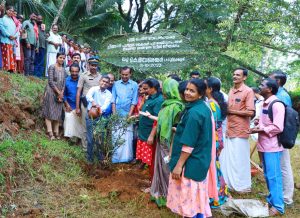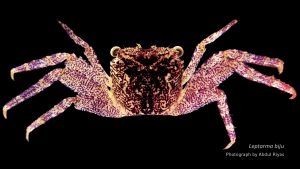|
Restoring a River and Recovering it’s original Riparian Biota |
|
|
|
The Kasaragod district in Kerala, home to twelve rivers, includes the smaller yet significant Chithari River. Originating near Iriya and flowing into the Arabian Sea at Ajanur village, this 25-kilometer-long river is among the last habitats for mangrove forests in northern Kerala. In 2020, a new tree-spider crab species, Leptarma biju, was discovered along the Chithari River banks. Recognizing the threats of riverine flora destruction and bank erosion, the Pullur Periya Biodiversity Management Committee (BMC) proposed a biodiversity survey and restoration of degraded land along the river’s banks, a project approved by the Kerala State Biodiversity Board (KSBB) for its uniqueness. The committee conducted a preliminary survey covering trees, shrubs, herbs, birds, spiders, butterflies, moths, odonates, mammals, and herpetofauna along a two-kilometer stretch between the Makkaramkodu and Velloor Vayal bridges. Unscientific river management and past floods had degraded this area significantly. Invasive species like trailing daisy (Sphagneticola trilobata) were abundant, prompting removal efforts by workers under the Mahatma Gandhi National Rural Employment Guarantee Scheme (MGNREGS). The BMC raised awareness about invasive species among MGNREGS workers and local residents, facilitated cleanups and planting efforts. The project included selecting and planting native species, taking two years for the first round despite concurrent invasive species removal and inventory preparation. The BMC continues to work towards the river’s ecological restoration. The Chithari River restoration project gained widespread acclaim from various sectors of society for its success in rejuvenating the river by maintaining its environmental flow. |
|
Mangroves Came Back! |
| |
|
Kerala is left with only a miniscule of its original mangrove forests. Mangrove ecosystems, vital for coastal protection, biodiversity, and carbon sequestration, face threats from deforestation, climate change, and urbanization in the state. Success stories, like the Avasatheeram project by the Pothencode block panchayath BMC funded by the Kerala State Biodiversity Board (KSBB), showcase the resilience of these ecosystems. Restoration efforts include the involvement of community participation, Planting of native mangrove species, protective measures and long term monitoring and research. Local fishermen and farmers were educated on the benefits of mangroves for coastal protection and fishery sector. Specialized training programmes were provided for MGNRES workers. Native mangrove species such as Sonnaratia alba, Rhizophora mucronata were replanted using locally sourced seedlings in a total stretch of 5 kilometers. Saplings and seeds were also purchased from JNTBGRI and workers germinated seeds in saline conditions. Bamboo fences were erected to protect saplings from strong tides and grazing animals. Continuous monitoring and scientific studies on soil health, water salinity, and mangrove growth ensured the effectiveness of the restoration efforts. The project helped in the restoration of the mangrove vegetation of the village, not only that the restored mangroves function as a protective bioshield against the coastal erosion. The block panchayath president says “The restored mangroves of our Panchayath are now attracting wildlife, including fish, crabs, and migratory birds, contributing to biodiversity. Restored mangroves have the potential to improve fish catches and ecotourism opportunities and boost local incomes”. The Avasatheeram project exemplifies successful ecological recovery and community-driven conservation, highlighting the importance of mangroves for environmental benefits and local livelihoods. |
|
Fostering Fresh Water Fish Spawning Aggregations |
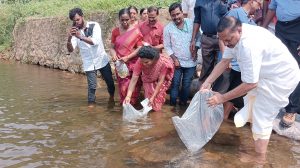 |
|
The Inland Fish Enhancement Project for safeguarding fish spawning aggregations, of Kerala State Biodiversity Board is a conservation oriented approach to sustain the biodiversity of inland fisheries in Kerala in collaboration with selected Biodiversity Management Committees. The monsoon season (Edavappathi) is the breeding time for inland fishes in Kerala. During this period, mature fish migrate to tributaries and paddy fields to lay eggs, a natural phenomenon called “Ootha ilakkam” or “Ootha kayattam.” Unfortunately, large-scale fishes were catches during this migration, locally known as “Ootha pidutham,” disrupts fish propagation and contributes to the decline of inland fish populations. This Inland Fish Enhancement project is a model for community based conservation effort of developing indigenous brood stock, raising fish seedlings and releasing them into the same river to recovering their population. This being promoted as a practice of protecting breeding fishes during their critical life stages and ensuring their safe propagation and thus revive declining fish stocks in Kerala’s rivers. In ultimate, this ensures the conservation of the fish stock and the ecological balance was maintained. As part of the project, Horabagrus brachysoma (Manjakoori), Heteropneustes fossilis (Kaari), Anabas testudineus (Kallemutti), Amblypharyngodon melettinus (Vayamb) are the fishes raised and released to River Pampa in first stage. The Inland Fish Enhancement Project is indeed a small but a significant step towards conservation of inland fishes. For a long term impact and sustainability, this initiative must be expanded and integrated into a broader conservation plan for the fresh water fish species of Kerala. The conservation campaign can bring in multiple stakeholders and beneficiaries involvement and lead into department level monitoring and documentation, citizen scientist involvement, demarcation of fish conservation zone, BMCs level policy regulation, etc. Through consistent awareness programs and community-driven approaches, conservation efforts like the ‘Ootha’ project can ensure long-term sustainability of fish populations and the ecosystem in Kerala’s rivers. |
|
Bringing back the Glory of ‘A Harithagramam’ |
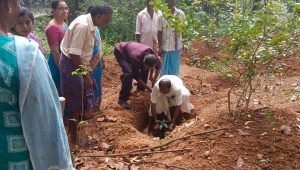 |
|
Situated in the foothills of the Western Ghats, Kuttichal Gramapanchayath in Trivandrum district is home to endemic plants and animals. The area’s biodiversity supports a wide range of species. Predominantly inhabited by tribal communities like the Muthuvan and Paniyas, who rely on agriculture and forest resources, Kuttichal is surrounded by lush forests, hills, and rivers, making it ecologically rich. The Kuttichal Biodiversity Management Committee (BMC), with financial and technical support from the Kerala State Biodiversity Board (KSBB), has successfully completed several conservation projects, including awareness programs, a tuber crop conservatory, land rice cultivation, restoration of the Kumbilmoodu River and a stingless bee conservation project. The KSBB sanctioned a Harithagramam project, which aims to establish a fruit garden at Kottor Ayurveda Medical College, promoting sustainable farming and improving tribal livelihoods. The project uses locally collected saplings of 25 indigenous fruit varieties, helping to restore soil fertility and prevent erosion. According to the BMC President, the fruit conservatory project enhances tribal farmers’ income and provides better nutrition for their families. Supported by MGNREGS and local agricultural experts, the project includes training on sustainable farming techniques, empowering the tribal people with new skills. The Kuttichal BMC’s projects are improving the region’s ecological health and uplifting the tribal communities socially and economically. These initiatives demonstrate how sustainable agriculture can foster environmental protection and community development. |
|
Safe Guarding the Egg Laying Habitats of Olive Ridley Sea Turtles |
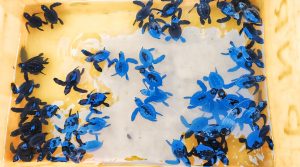 |
|
The Kerala State Biodiversity Board (KSBB) initiated a conservation project for the vulnerable Olive Ridley sea turtle (Lepidochelys olivacea) at the coastal Grama Panchayat Veliyamcode, Malappuram. This species, listed as vulnerable in the IUCN Red Data Book and protected under Schedule I of the Wildlife (Protection) Act, 1972, faces threats from stray dogs, jackals, cats, birds, and local superstitions regarding the medicinal use of their eggs. The Veliyamcode LSGD’s Biodiversity Management Committee (BMC) and KSBB have been conducting a community-level conservation program since 2021. Quarterly BMC meetings, especially before the egg-laying season, and awareness classes for the local community emphasized the importance of sea turtle conservation. Volunteers collected turtle eggs during each season, placing them in sand digs protected by metal pipe cages. During 2021-22, 4095 eggs collected while in 2022-23, 4058 eggs collected and in 2023-24, 4535 eggs were collected and conserved as part of the project. The project included awareness classes, beach cleaning and observation, volunteering programs and enhancing community involvement. The BMC is now planning a facilitation center for future community-level conservation activities and for the widespread awareness programs. |
|
A Biodiversity-rich Panchayath shows Sustainable Development. |
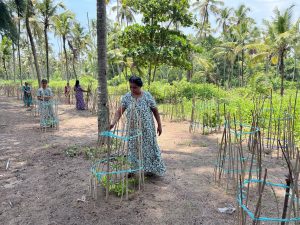 |
| The Sreenarayanapuram Biodiversity Management Committee (BMC) received the prestigious Best BMC Award of KSBB, for its comprehensive and impactful biodiversity conservation initiatives. Their projects span a wide range of areas, demonstrating a strong commitment to biodiversity conservation and community involvement. Key Initiatives and Projects done by the BMC include the Community Participation Initiatives, updates to document local biodiversity and Publishing additional volumes and digital versions of the PBR, Preserving traditional sacred groves as biodiversity hotspots, Conducting detailed studies to understand and protect local ecosystems, Educating the community on the importance of biodiversity, Implementing restoration projects for local ecosystems, Identifying and preserving important local biodiversity heritage sites, Regular BMC meetings to plan and review conservation activities, Planting trees to restore native forests, Promoting diverse crop cultivation for food security, Restoring coastal ecosystems, Establishing parks to protect and showcase biodiversity, Reviving mangrove forests, Growing rare, endangered, and threatened species, establishment of endemic plant nurseries, Biodiversity training for employees of Mahatma Gandhi National Rural Employment Guarantee Scheme and establishment of plant walls in coastal areas. The BMC has Undertaken 13 ecorestoration projects, Tuber crop conservatories and Promotion of geographical indication-tagged cucumber. The BMC is keen in coordinating with various departments for effective implementation of conservation schemes. The BMC has also established gardens for medicinal plants, facilities for eco-friendly waste management and encourages students to adopt eco-friendly practices. The BMC motivates the biodiversity clubs of Sreenarayanapuram for establishing conservatories including land rice and flowering plants. Through these initiatives, Sreenarayanapuram BMC has significantly improved the ecological health of the region, demonstrating how sustainable practices can foster both environmental protection and community development. |
|
Inspiring Young Minds to Explore Biodiversity Science |
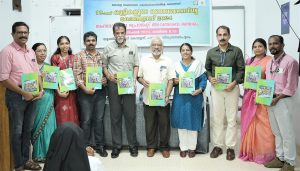 |
| For the past 15 years, the Kerala State Biodiversity Board (KSBB) has conducted the Children’s Biodiversity Congress (CBC) to educate young minds on the importance of biodiversity conservation. First phase of the event includes district-level competitions in painting, pencil drawing, essay writing, and project presentations for senior and junior school students. State-level winners are selected from district champions in all categories. In the 16th CBC, over 3500 students from all districts participated in the district-level competitions. The state-level project presentation competition was held on December 7, 2024, at University College, Thiruvananthapuram, where district level first prize winners of project presentation competitions presented their projects. 27 projects were presented in both Senior and Junior category. State winners were selected and the prize distribution was done on 11 December 2024 at Thiruvananthapuram. KSBB has published the ‘Book of Abstracts of the Projects’ which highlights the innovative ideas of the young participants. |
|
Strengthening Sacred Cultural Roots to Safeguard Sacred Groves |
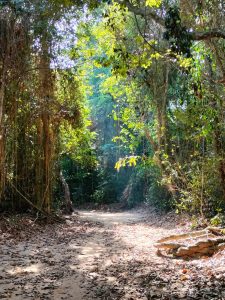 |
| Poilkavu Sacred Grove, located in Chengottukavu Panchayath, Kozhikode district, spans 11.04 acres and is a testament to the region’s rich cultural and ecological heritage. Adjacent to the Poilkavu Durga devi Temple and near the Arabian Sea, it is the largest sacred grove in Northern Kerala, teeming with biodiversity. The grove’s unique geography, climate, and soil conditions create a haven for diverse flora and fauna. It supports 197 plant species within 57 families, including 16 listed in the IUCN Red List. The grove also plays a crucial role in providing ecosystem services, such as clean water, air, soil regulation, climate control, and erosion prevention, while preserving traditional knowledge of ancient practices and medicinal plant uses. Despite its importance, Poilkavu Sacred Grove faces threats from invasive plants, plastic waste, human encroachment, waterlogging, and plant damage due to poor drainage. Urgent restoration and conservation efforts are required to protect its biodiversity. The Chengottukavu Gramapanchayath BMC has requested the Kerala State Biodiversity Board (KSBB) to designate Poilkavu as a Biodiversity Heritage Site (BHS). Following a detailed analysis and public hearing in July 2024, a study report, along with authorization, boundary estimation, and ownership certificates, was submitted. The BMC urged collective action to preserve Poilkavu Sacred Grove, maintain groundwater levels, and safeguard coastal ecosystems for future generations. |
|
Bridging Champions for Nature |
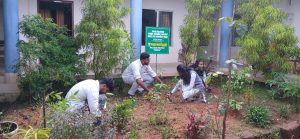 |
| The Kerala State Biodiversity Board (KSBB) has established over 2000 biodiversity clubs in educational institutions across the state, engaging more than 60,000 students in various conservation initiatives and awareness programs. Each club is led by a teacher coordinator and comprises of at least 30 student members, with KSBB providing financial and technical support. The biodiversity clubs, supported by the Kerala State Biodiversity Board (KSBB), engage in various projects such as medicinal plant gardens, butterfly gardens, fruit conservatories, rice conservation, bioparks, and biodiversity surveys. They also create sensory gardens and observe environmental days. To build capacity for the biodiversity clubs, KSBB conducts regular online and offline training sessions by biodiversity experts. Additionally, 9 monthly talk series were held during 2023-2024.Through these initiatives, KSBB’s biodiversity clubs are fostering a generation of environmentally conscious young individuals dedicated to conserving their natural heritage. |
| Sowing Seeds of Sustainable Farming: Story of a Conservation Farmer |
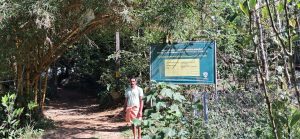 |
| Jaison P George, Puliyanmackal H.,Venmani PO.,Pattayamkudy, Idukki District
Mr. Jaison P George has dedicated his life to sustainable farming practices. Nestled in the Western Ghats, his farm exemplifies a Food Forest with its diverse array of crops, including fruit trees, tubers, vegetables, medicinal plants, and spices, showcasing the power of sustainable farming. Jaison’s farming is rooted in permaculture principles, emphasizing working with nature to create a sustainable and regenerative ecosystem. He uses natural pest and disease control methods and conservation measures to protect soil and water resources. Inspired by his father, Mr. P.G. George, a listed farm school farmer by the Kerala State Biodiversity Board, Jaison continues his father’s legacy with passion. Mr. Jaison’s farm cultivates a variety of crops including fruit trees, vegetables, grains, spices and medicinal plants. The farm also houses cows, goats, and chickens, providing organic manure for fertilization. It features indigenous varieties, including the cardamom “Kanni elam,” known for its high yield and disease resistance. According to the custodian farmer, combining traditional and modern techniques ensures sustainable and regenerative practices. Jaison’s focus on sustainability and biodiversity has made his farm a model for others in the region. His commitment not only preserves the natural beauty of his land but also provides a source of income for his family. Jaison’s farm stands as a testament to sustainable farming and biodiversity conservation. His dedication is an inspiration, reminding us of the importance of living in harmony with nature. |
